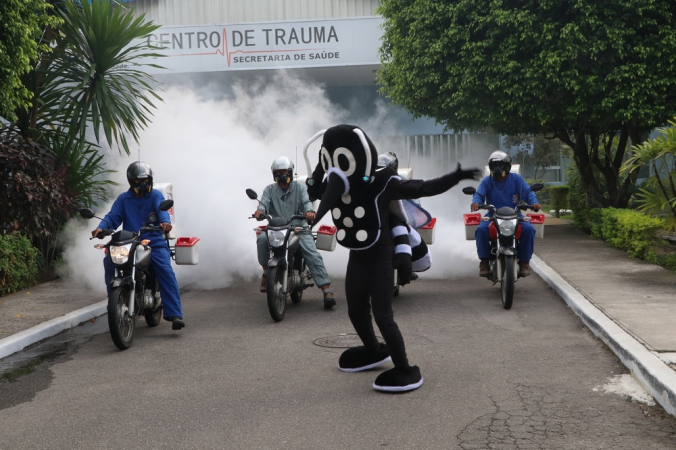- By Helena Degreas para a Jovem Pan News
- 20/04/2024 09h00 – Atualizado em 20/04/2024 14h24
In the first 14 weeks of 2024, Brazil has recorded 3.1 million probable dengue fever cases and 1,292 deaths. The country’s response has been characterized by government inaction, a limited understanding of the problem, and an unbridled pursuit of profits, creating a chaotic scenario.

Awareness campaign to combat dengue in São Gonçalo, in the metropolitan region of Rio de Janeiro.
A recent World Economic Forum article titled ‘Every Decision is a Climate Decision’ highlights a series of concerning global abnormalities. Devastating floods, brutal heatwaves, prolonged droughts, and uncontrollable wildfires marked 2023, becoming increasingly frequent and intense, causing human losses, material damage, and devastating socio-economic impacts.
Biodiversity loss, a direct consequence of human interference, disrupts the environmental balance and generates various material impacts, threatening people’s lives and health. Protecting all living beings on the planet, particularly terrestrial biodiversity in urban areas, is an urgent global task requiring immediate action from governments, businesses, and individuals.
The National Health Council (NHC) recently presented alarming statistics: Brazil faces the worst dengue epidemic in years, with the potential to be deadly. Data from the Pan American Health Organization (PAHO) indicates that Brazil reached 3.1 million probable cases of dengue in the first 14 weeks of 2024, with 1,292 deaths confirmed and 1,875 under investigation.
A complex relationship exists between the destruction of urban biodiversity and climate change. Rising temperatures and extreme weather events like heavy rains create ideal conditions for mosquito reproduction. Uncontrolled urban sprawl with inadequate planning leads to deficiencies in basic sanitation infrastructure, creating breeding grounds for mosquitoes, such as areas with garbage accumulation and poor drainage.
Dealing with future outbreaks and epidemics requires more than public education campaigns and inspections aimed at eliminating mosquito breeding sites. While education is crucial to raise awareness about individual responsibility, rebuilding urban biodiversity is equally vital.
Municipal offices and departments are flooded with a flurry of plans focused on specific solutions, as if drafting them alone guarantees the desired results.
On one hand, these plans demonstrate public officials’ efforts to align with Agenda 2030 goals. However, a glaring gap exists between intention and action regarding urban decarbonization. The inertia of authorities, a limited understanding of the problem, and the relentless pursuit of immediate profits by some sectors create a chaotic scenario. The effectiveness of urban policies and actions gets lost amidst bureaucracy and a lack of commitment, hindering swift and effective responses to socio-environmental changes. Fragmented collaboration between agencies, riddled with conflicting interests and duplicated efforts, leads to delays, wasted resources, and unequal distribution of investments. An integrated and collaborative approach involving all stakeholders is urgently needed to ensure the preservation of urban biodiversity.
The Singapore Biodiversity Index (SI) emerges as a sophisticated tool. By covering 28 analysis categories, the SI can provide a comprehensive view of the state of biodiversity through measurement and monitoring. It also helps formulate effective urban plans and policies, serving as a solid foundation for strategic decisions and targeted actions. This is achieved through data collection, analysis, and utilization.
A critical question remains: How do we measure and monitor the effectiveness of government efforts to recover urban biodiversity and improve a city’s ability to resist, adapt to, and recover from environmental impacts caused by climate change?
From adapting to climate change and building urban resilience to managing natural resources and controlling invasive species, we need metrics and comprehensive data to provide a detailed overview of implemented strategies and policies aimed at improving environmental and climatic conditions. This ultimately protects the health and lives of citizens and contributes to a future with significantly fewer outbreaks and epidemics caused by insects.
By examining public participation, environmental education, and green infrastructure, the index seeks to promote collaboration between public, private, and civil society entities. This collaboration aims to ensure a more sustainable and resilient urban environment for future generations. In addition to the mentioned analysis categories, the urban biodiversity index also addresses topics such as natural habitat conservation, ecological corridor protection, urban agriculture promotion, water recharge area preservation, and mitigating the impacts of urbanization on native fauna and flora.
These additions further expand our understanding of and promote a holistic approach to dealing with the challenges of biodiversity in cities. This, in turn, encourages the implementation of more effective policies and practices for the protection of the urban environment.
